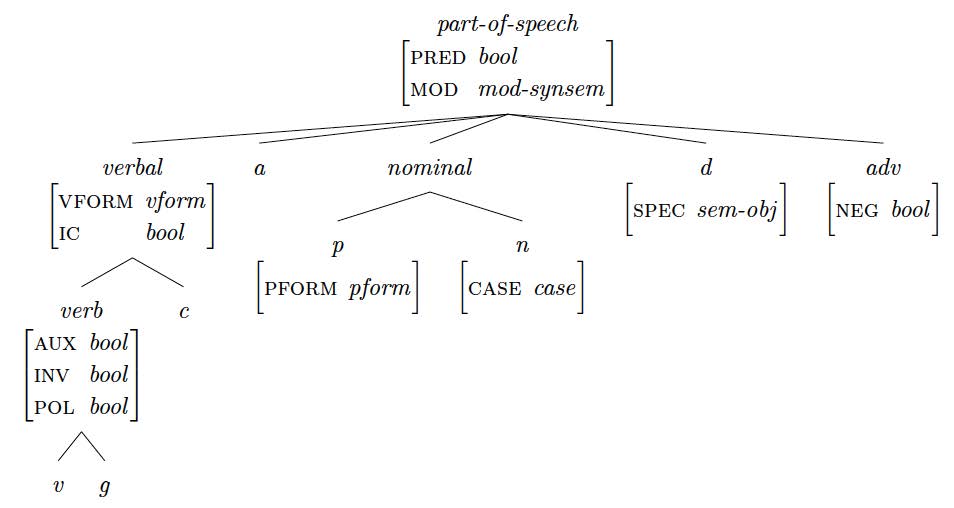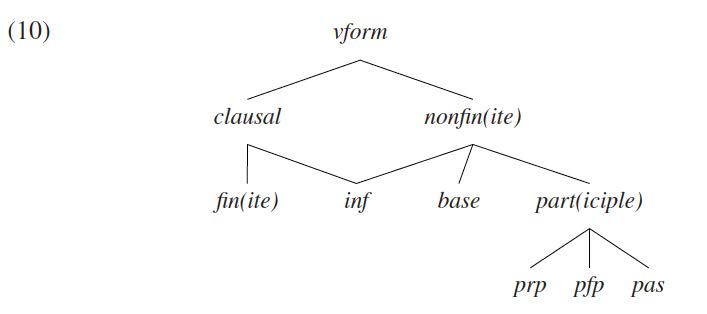Constraint-based Syntax 2: Week 2
Parts of Speech
Our online grammar uses the following type hierarchy for parts of speech (the values of the feature HEAD):
The hierarchy differs from that in GS in containing the part of speech adverb. The following table lists the parts of speech, their features, and the function of the features:
| Part of speech | Feature | Value type | Function of the feature |
|---|---|---|---|
| part-of-speech | PRED | boolean | Is the expression predicative or not? |
| MOD | mod-synsem | Can the expression modify and if yes, what kind of synsem? | |
| verbal | VFORM | vform | What is the verb's verb form? |
| IC | boolean | Is the expression (the head of) an independent clause? | |
| verb | AUX | boolean | Is the expression (the head of) an auxiliary construction? |
| POL | boolean | Is the verb a polarized auxiliary (not, TOO, so)? | |
| INV | boolean | Is the expression an inverted auxiliary (construction)? | |
| v |
Head Features
The part of speech v
v is the part of speech of all verbs and auxiliaries, including the infinitive marker to.
The table below is to be interpreted as follows. In the leftmost column, we find parts of speech. The top-to-bottom order represents the immediate subtype relationship, i.e. verbal is an immediate subtype of subst, verb is an immediate subtype of verbal, and v is an immediate subtype of verb.
The second column lists the features introduced by each part of speech, followed in the third column by the value type of the feature, and finally a short statement of the function of the feature in distinguishing different subgroups of the part(s) of speech under discussion.
| Part of speech | Feature | Value type | Function of the feature |
|---|---|---|---|
| subst | PRED | boolean | Is the expression predicative or not? |
| MOD | mod-synsem | Can the expression modify and if yes, what kind of synsem? | |
| verbal | VFORM | vform | What is the verb's verb form? |
| IC | boolean | Is the expression (the head of) an independent clause? | |
| verb | AUX | boolean | Is the expression (the head of) an auxiliary construction? |
| POL | boolean | Is the verb a polarized auxiliary (not, TOO, so)? | |
| INV | boolean | Is the expression an inverted auxiliary (construction)? | |
| v |
Let us now ask what this means for expressions of part of speech v. v itself does not introduce any features, but since every v is also a verb, a verbal, and a subset, an expression of part of speech v has all the features introduced by its supertypes and the corresponding values:
[v
[PRED boolean]
[MOD mod-synsem]
[VFORM vform]
[AUX boolean]
[POL boolean]
[INV boolean]]
Task: go to the online grammar and parse the following words in order to see the values for their head features:
a. like, likes, liked, liking
Note that those verb forms which can serve as the complement of the verb be (the passive liked and the progressive liking) are [PRED plus], whereas all the remaining forms are [PRED minus]. Also, all main verbs are [AUX minus], from which it follows that they cannot occur in auxiliary constructions.
b. does
The forms of the unstressed auxiliary do are the only words of English which are restricted to occurring in auxiliary constructions. Thus, they are all marked [AUX plus]. Note that all the forms of the auxiliary do are finite.
You get two solutions when you parse does, one which is [POL minus] and a second one which is [POL plus]. You will notice that this contrast goes along with a difference in COMPs lists of the two verbs. The non-polarized verb has a single complement, namely a VP, whereas the polarized word selects an additional complement, namely a polarized adverb (one of the words not, TOO, or so).
c. will
This is a typical modal verb. Like the other modals, it has only finite forms. Again you get two solutions, a polarized and a non-polarized one. An intriguing difference between will and the unstressed do discussed above, is that will can occur in auxiliary constructions (and then is [AUX plus]), but it can also occur in constructions where main verbs can occur as well (and then, like the main verbs, will be [AUX minus]. In order to be compatible with both values of the feature AUX, will, it takes the neutral value [AUX boolean] in its lexical entry. All verbs that can appear in auxiliary constructions except for the forms of the unstressed do behave like will.
The Argument Realization Principle (ARP)
Recall that in GS the syntactic arguments of a word are in a sense represented twice: once on the ARG-ST (argument structure) list which, among others, is used for Binding Theory, and again on one of the valence lists SUBJ, SPR, and COMPS. Rather than being arbitrary, the relationship between the ARG-S and the valence lists is governed by the Argument Realization Principle:
In words, the principle says that the ARG-ST list is the result of merging the three valence lists into one list, with the elements of the SUBJ list coming first, followed by the elements on the SPR list, followed, finally, by the elements on the COMPS list.
Besides the ARP, the valence properties of words depend on their part of speech. Thus, all words of part of speech v must have a SUBJ list with exactly one element on it and a SPR list which is empty. In combination with the ARP, verbs of part of speech v thus must have the following properties:
- The ARG-ST must have at least one element on it.
- The first element of the ARG-ST is also the single element on the SUBJ list.
- If there are additional elements on the ARG-ST, then these elements also occur on the COMPS list.
- The elements which appear both on the ARG-ST and the COMPS list, appear in the same order on both lists.
The following Exercises on the append relation have the purpose of showing that the 4 statements above must be true.
Exercises on the Argument Realization Principle


